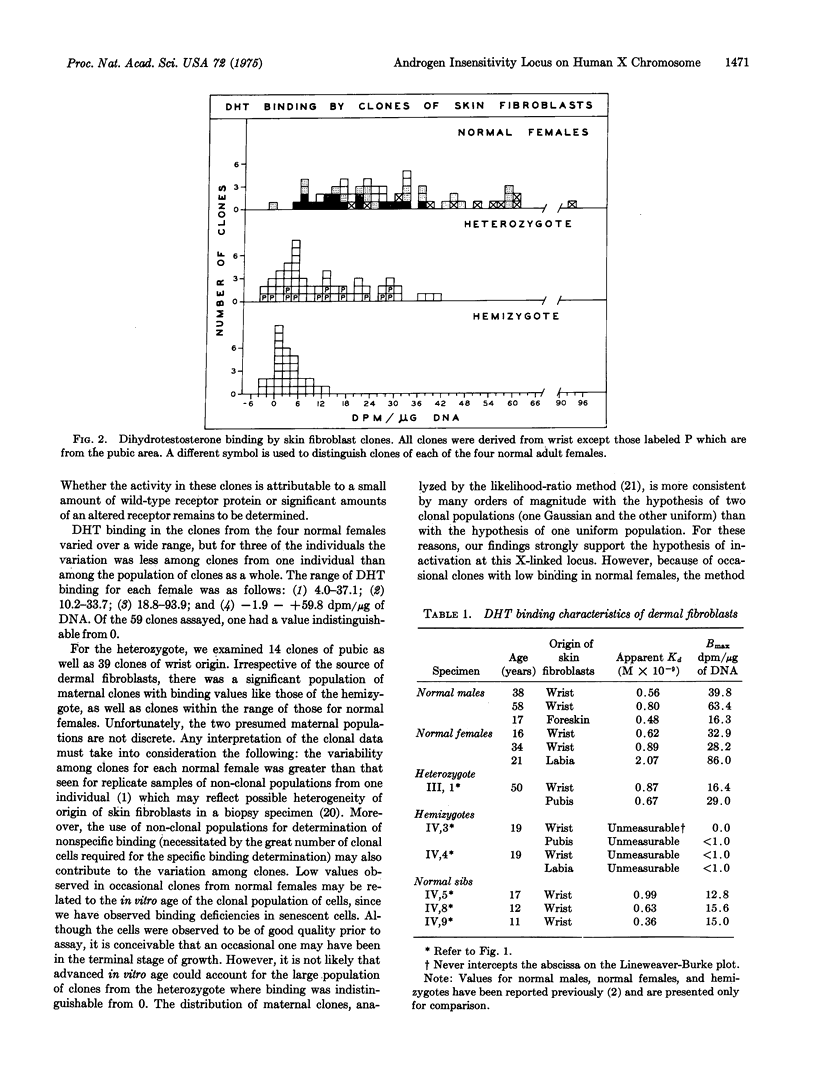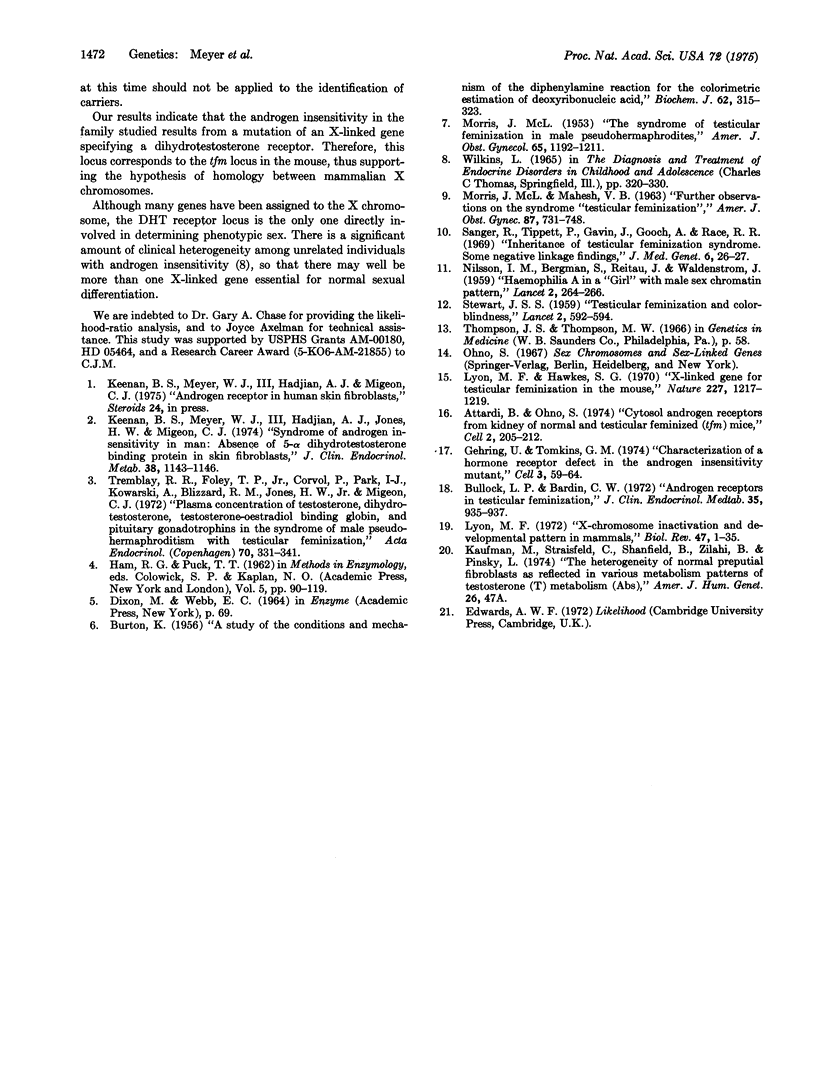Abstract
We have studied androgen binding characteristics of cells for androgen insensitivity from an obligate heterozygote, who is the mother of three male pseudohermaphrodites with dihydrotestosterone (17beta-hydroxy-5alpha-androstan-3-one) receptor deficiency. Specific dihydrotestosterone binding by skin fibroblasts from her wrist and pubis is within the normal range and indicates that androgen insensitivity is X-linked in man and is therefore homologous to the tfm locus in the mouse. A significant population of clones from the heterozygote has deficient receptor activity, and this finding is compatible with inactivation of one X-linked allele at this locus. Our results indicate the presence of a gene on the human X chromosome that is essential for normal male sexual differentiation and provide further evidence for homology between X chromosomes of all mammals.
Full text
PDF



Images in this article
Selected References
These references are in PubMed. This may not be the complete list of references from this article.
- Attardi B., Ono S. Cytosol androgen receptor from kidney of normal and testicular feminized (Tfm) mice. Cell. 1974 Aug;2(4):205–212. doi: 10.1016/0092-8674(74)90012-9. [DOI] [PubMed] [Google Scholar]
- BURTON K. A study of the conditions and mechanism of the diphenylamine reaction for the colorimetric estimation of deoxyribonucleic acid. Biochem J. 1956 Feb;62(2):315–323. doi: 10.1042/bj0620315. [DOI] [PMC free article] [PubMed] [Google Scholar]
- Bullock L. P., Bardin W. C. Androgen receptors in testicular feminization. J Clin Endocrinol Metab. 1972 Dec;35(6):935–937. doi: 10.1210/jcem-35-6-935. [DOI] [PubMed] [Google Scholar]
- Gehring U., Tomkins G. M. Characterization of a hormone receptor defect in the androgen-insensitivity mutant. Cell. 1974 Sep;3(1):59–64. doi: 10.1016/0092-8674(74)90040-3. [DOI] [PubMed] [Google Scholar]
- Keenan B. S., Meyer W. J., 3rd, Hadjian A. J., Jones H. W., Migeon C. J. Syndrome of androgen insensitivity in man: absence of 5 alpha-dihydrotestosterone binding protein in skin fibroblasts. J Clin Endocrinol Metab. 1974 Jun;38(6):1143–1146. doi: 10.1210/jcem-38-6-1143. [DOI] [PubMed] [Google Scholar]
- Lyon M. F., Hawkes S. G. X-linked gene for testicular feminization in the mouse. Nature. 1970 Sep 19;227(5264):1217–1219. doi: 10.1038/2271217a0. [DOI] [PubMed] [Google Scholar]
- Lyon M. F. X-chromosome inactivation and developmental patterns in mammals. Biol Rev Camb Philos Soc. 1972 Jan;47(1):1–35. doi: 10.1111/j.1469-185x.1972.tb00969.x. [DOI] [PubMed] [Google Scholar]
- MORRIS J. M., MAHESH V. B. FURTHER OBSERVATIONS ON THE SYNDROME, "TESTICULAR FEMINIZATION". Am J Obstet Gynecol. 1963 Nov 15;87:731–748. [PubMed] [Google Scholar]
- MORRIS J. M. The syndrome of testicular feminization in male pseudohermaphrodites. Am J Obstet Gynecol. 1953 Jun;65(6):1192–1211. doi: 10.1016/0002-9378(53)90359-7. [DOI] [PubMed] [Google Scholar]
- NILSSON I. M., BERGMAN S., REITALU J., WALDENSTROM J. Haemophilia A in a "girl" with male sex-chromatin pattern. Lancet. 1959 Sep 5;2(7097):264–266. doi: 10.1016/s0140-6736(59)92058-6. [DOI] [PubMed] [Google Scholar]
- STEWART J. S. Testicular feminisation and colour-blindness. Lancet. 1959 Oct 17;2(7103):592–594. doi: 10.1016/s0140-6736(59)91695-2. [DOI] [PubMed] [Google Scholar]
- Sanger R., Tippett P., Gavin J., Gooch A., Race R. R. Inheritance of testicular feminization syndrome: some negative linkage findings. J Med Genet. 1969 Mar;6(1):26–27. doi: 10.1136/jmg.6.1.26. [DOI] [PMC free article] [PubMed] [Google Scholar]
- Tremblay R. R., Foley T. P., Jr, Corvol P., Park I. J., Kowarski A., Blizzard R. M., Jones H. W., Jr, Migeon C. J. Plasma concentration of testosterone, dihydrotestosterone, testosterone-oestradiol binding globulin, and pituitary gonadotrophins in the syndrome of male pseudo-hermaphroditism with testicular feminization. Acta Endocrinol (Copenh) 1972 Jun;70(2):331–341. doi: 10.1530/acta.0.0700331. [DOI] [PubMed] [Google Scholar]



